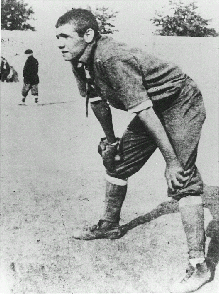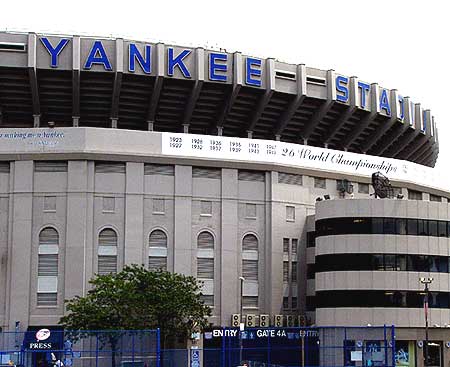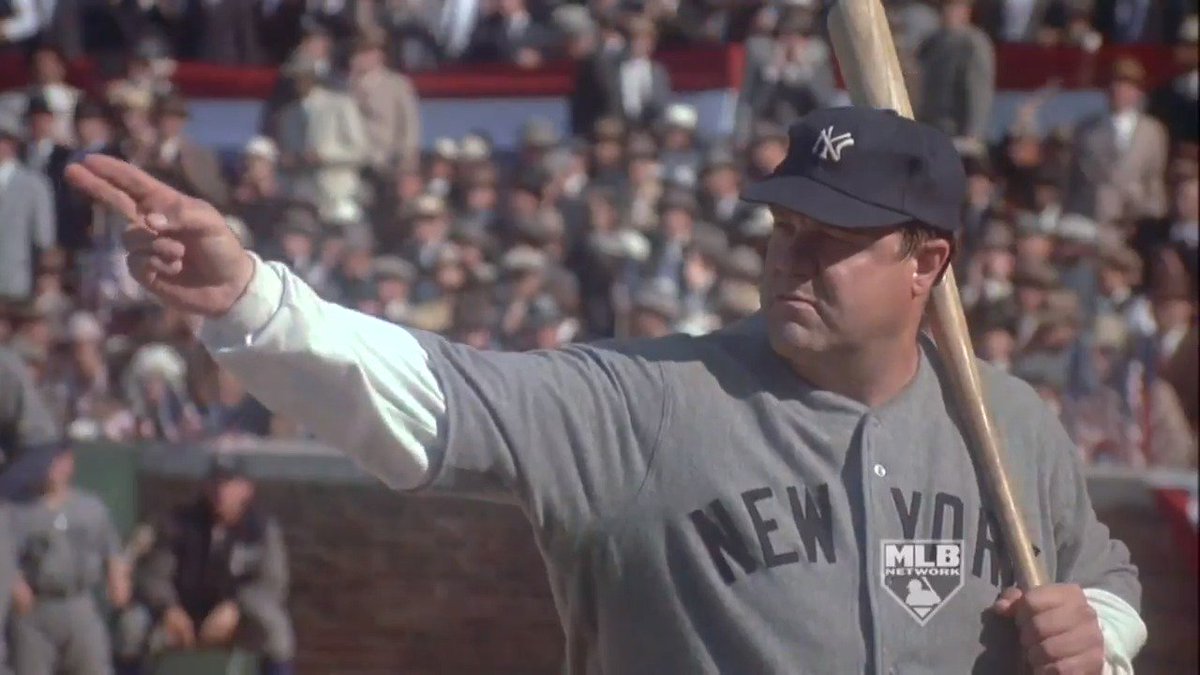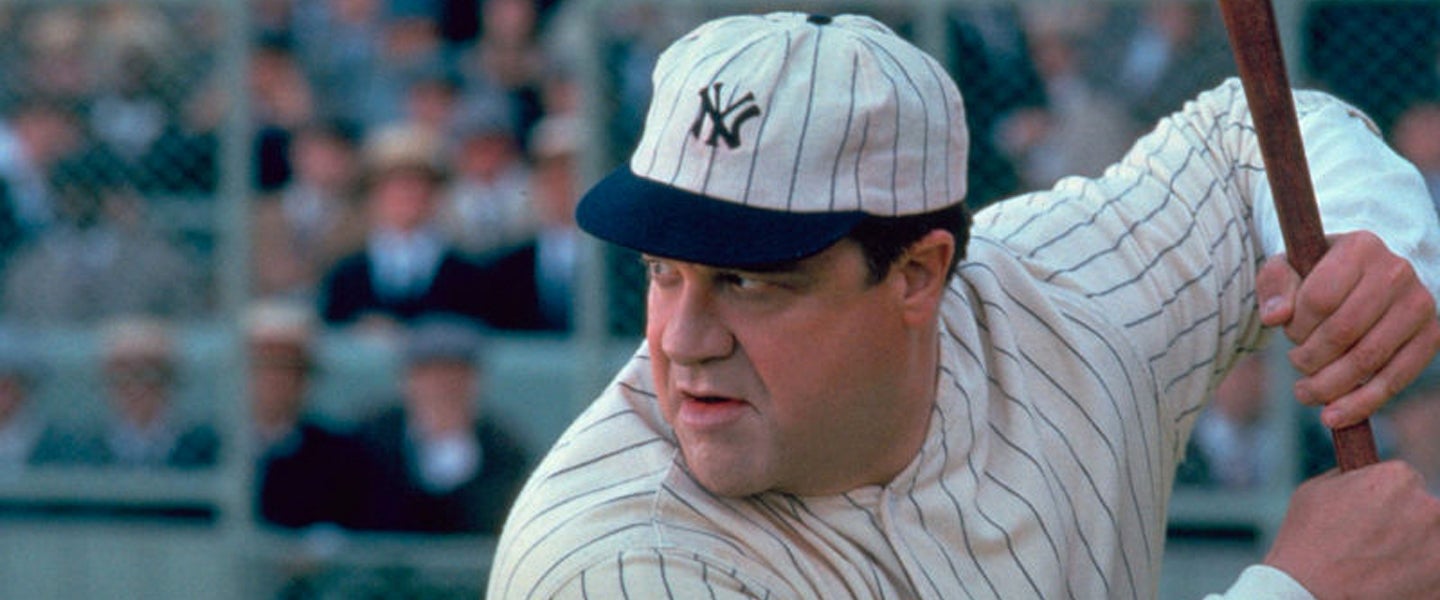“George Herman ‘Babe’ Ruth Jr. was an American professional baseball player whose career in Major League Baseball spanned 22 seasons, from 1914 through 1935. Nicknamed ‘The Bambino’ and ‘The Sultan of Swat,’ he began his MLB career as a star left-handed pitcher for the Boston Red Sox, but achieved his greatest fame as a slugging outfielder for the New York Yankees. Ruth established many MLB batting (and some pitching) records, [and] is regarded as one of the greatest sports heroes in American culture and is considered by many to be the greatest baseball player of all time.”
The above is copied and pasted from the Wikipedia page on Babe Ruth, and, congratulations, by reading that you already know more about “The Babe” than anyone involved in the 1992 movie The Babe starring John Goodman.
Upon its release, The Babe was panned by critics for its uneven tone, small scale and lackluster performances — even Goodman has admitted that the film was far from his best work. But the film bothered no one more than baseball experts, who chided at the film’s utter disregard for facts that were easily accessible (even in the days before Wikipedia). So, to get off their chests what’s been bugging them for almost 30 years, here are some baseball historians to offer up their problems with The Babe, their thoughts on the actual Babe and their opinions of Goodman as, yes, “The Babe.”
On How the Film Portrays Babe’s Childhood
Edmund F Wehrle, professor of history at Eastern Illinois University and author of Breaking Babe Ruth: Baseball’s Campaign Against Its Biggest Star: They start off in the film with a chubby kid playing Ruth and that is absolutely not the truth. Until the early 1920s Ruth was not only slim, but almost skeletal. If you look at pictures of him playing at St. Mary’s orphanage, he’s very, very slim.

Ralph Carhart, baseball historian and creator of The Hall Ball: They also messed around with his familial relationships. They had it so that his parents brought him to St. Mary’s orphanage and that was it, he never saw them again, but that wasn’t true — he was brought to St. Mary’s because he was an incorrigible youth, but he frequently left St. Mary’s and he frequently went home and he frequently worked in his father’s saloon. He even bought his father a nicer saloon after he began playing with the Red Sox.

On the Legend of Babe Ruth
Carhart: Rather than make a real biopic, the movie collected a bunch of stories and myths from baseball legends — some of which don’t even apply to Ruth — slapped them in there and called them fact. Perhaps nothing in the movie is more offensive than the first words on the screen when it says, “The following incidents are based on true events that occurred between 1902 and 1935.” Remove that entirely and the movie is much less offensive.
Perhaps its greatest sin is that the movie focuses entirely on his ability to hit home runs. He was an incredible pitcher, and if he never became the hitter he did, he likely still would be in the Hall of Fame. He was multifaceted and had all the skills a baseball player needs. That’s probably the movie’s greatest disservice — it took baseball’s most well-rounded character and turned him into a two-dimensional cartoon.
Glenn Stout, author of The Selling of the Babe: The Deal That Changed Baseball and Created a Legend and Yankees Century: 100 Years of New York Yankees Baseball: Like so many sports films, they seem to do everything they can to tick off their core audience, which is the people who are most into the sport. In The Babe, they take this person who was an incredible athlete and turn him into this cartoonish fat person from the very beginning, which he was not, so you lose what was kind of special about him. If you already didn’t know about Babe Ruth before watching this film, you would wonder why the movie was made, because he’s not very interesting in it and you don’t even really get that he was a great ballplayer.
It also falls into that classic trap mentioned in The Man Who Shot Liberty Valance, which is, “When the legend becomes fact, print the legend” — so they print the legend instead of being accurate. Now, I understand that you have to do some of that in film, I get that, but it’s disquieting when you see it done to this degree, like there’s this silly thing about the pop-up that doesn’t come down, which is absolutely ridiculous.
Wayne Stewart, sportswriter and author of Babe Ruth: A Biography and Wits, Flakes and Clowns: The Colorful Characters of Baseball: One of the most absurd things to me in the film is when he hits a pop fly and everyone is looking up, trying to see the ball and they can’t find it, and then Ruth is rounding third by the time the ball hits the ground, which means he essentially ran more than the length of a football field before it touched the ground, which is impossible. That would take maybe eight or 10 seconds at most which isn’t nearly enough time for Ruth to get that far.
Wehrle: The factual issues, I think, aren’t beyond the pale. It’s a biographical movie and it’s set out as fable-like from the beginning, so you can excuse some of the license that they take with the facts. The main problem with the movie is that it reinforces a narrative and all of these tropes that were established about Ruth by the baseball establishment. This narrative was established early on, and it was designed to keep this rebellious, charismatic athlete under control.
In some ways, Ruth was a threat to Major League Baseball. Back in the 1920s, the MLB was under stress from rival baseball leagues, and baseball almost missed an entire season during World War I. There were also attacks on baseball’s very draconian labor system. Then there was this guy — Babe Ruth — who was more attractive to fans than any other baseball player before or since, and he was an outspoken guy and he’d been an outspoken member of a baseball union. The threat was that a player of Ruth’s stature could break away from Major League Baseball and start his own league, which was a very real threat that baseball was looking to contain. He was also driving up payrolls and clashing with the powers-that-be; he had problems with the reserve clause, too, which bound players to teams until it was dropped in the 1970s. Back in Ruth’s day, everything was weighted in favor of the ownership and Ruth threatened their control because of his popularity, so they wanted this guy under control. They wanted to exploit him and they wanted him out there, but they also wanted him under control.
To do that, they portrayed Ruth as a guy who was out of control as a partier and a womanizer. Once they managed to get that story to stick, it was difficult for Ruth to live down. The owners at the time also subsidized the sportswriters at the time, so they towed the ownership line, and the ownership line was that Ruth was a child — an overgrown kid who isn’t in control of himself. He was a little out of control, but not to the level shown, and even when he was in his partying prime, it was exaggerated.
Carhart: The tragedy is that when you’re telling the story of Ruth, you don’t need to make up all these stories. Ruth’s own story is incredible.

On “The House That Ruth Built”
Stout: The movie starts out with this shot of modern Yankee Stadium, or at least, modern in 1992, and it had been a while since I’d seen the film, so I kept waiting for it to transform into the old Yankee Stadium or something like that and it doesn’t. Yankee Stadium didn’t look like that until the renovation in the mid-1970s, when Ruth’s Yankee Stadium was changed and the facade was changed, though it evolved throughout that time. If you want to see what Yankee Stadium looked like back then, there’s a great Buster Keaton short where he’s in an empty ballpark — it’s spectacular looking.
Even though they called Yankee Stadium “The House that Ruth Built,” I always argue that it was the house that was built for Ruth, because when he first played for the Yankees from 1920 to 1922, they played at the Polo Grounds of the New York Giants [baseball team], but the Yankees got into a dispute with the Giants and they had to build their own stadium. When they did that, they built a stadium that Ruth could thrive in by bringing in the outfield. Had he stayed in Fenway with the Red Sox, he wouldn’t have had nearly as many home runs because right field was far more distant there than in the Polo Grounds or at Yankee Stadium.
Now, it is true that Ruth brought in the money for the Yankees to build that stadium, but they were getting kicked out by the Giants, so they were going to need to build a ballpark anyway.

On the Infamous “Called Shot”
Stout: It was Game Three of the 1932 World Series — the Yankees versus the Cubs — and there’s no question that Ruth made some gestures. He was being razzed by the Cubs, and he was giving it right back to them. There are films of it, but it’s unclear if he’s pointing to the outfield or pointing at the Cubs’ dugout — you really can’t tell.
The story was written two days later that Ruth pointed to the sky and called his shot, saying exactly where he was going to hit it to, and Ruth, however, was smart enough not to disagree when people asked him about it later. He knew legends work pretty good, too.
The called shot is one of those things where it almost doesn’t matter if he did it or not because with Ruth, it was plausible, which is still untrue of any other player. The reason why I say that is because everything Ruth was doing at the time was so far beyond what any player had done before. He started an entirely new way of hitting. Before then, people slapped at the ball, but after him, they swung from the heels. Prior to him, home runs were accidental because originally baseball was played scientifically, which means you’d do a slap hit, steal a base and bunt to bring a guy home — that was baseball before World War I.
Back then, the worst thing a hitter could do was strike out, they just wanted to make contact, but Ruth wanted to hit it hard — he liked that. He also swung with an uppercut, which no one had done before, and the fans also really responded to home runs. That’s why you went from a time where leading the league in home runs meant you’d hit 10 or 12 of them to Ruth hitting over 50 and eventually 60. That’s why I say the called shot was at least plausible, because back then, it seemed like he could do anything.
On the Johnny Sylvester Story
Charlie Poekel, author of Babe & the Kid: The Legendary Story of Babe Ruth and Johnny Sylvester: Pretty much everything is wrong with this movie as far as the Johnny Sylvester story goes, which they don’t have to do because the accurate facts are just as impressive as they are in the movie. In the movie they show this father trying to get Ruth’s attention about his sick boy, then Babe visits him in the hospital and Babe offers to hit a home run for him, then Johnny Sylvester holds up two fingers asking him to hit two, which is incorrect.
In real life, Johnny Sylvester had been injured from falling off a horse. He was 11 and suffering from osteomyelitis. He just couldn’t get better, but he never went to a hospital like he did in the movie, so that’s not true that Babe visited him in the hospital. Sylvester’s father was also a powerful bond trader in New York City, and he went to the vice president of his bank, who had a connection with some sportswriters, and they passed a baseball around to both dugouts during the 1926 World Series. Babe wrote on the ball that he’d knock a homer for Johnny in tomorrow’s game. So the next day comes and it’s Game Four of the World series and Ruth hits not one, not two, but three home runs for Johnny — it made a great story.
The Yankees lost to the Cardinals in the series, but the next day, Ruth rode out to Johnny’s house in New Jersey and surprised him with another baseball, which got more publicity to the story.
There’s also a pretty funny story that happened a few weeks after all this, when Ruth is approached on the street by a man who introduces himself saying he’s Johnny Sylvester’s uncle. The uncle was thanking Ruth for all that he did for Johnny, and Ruth says, “Thank you.” Then the uncle walks away, and Ruth turns to the person he was with and says, “Who the hell is Johnny Sylvester?” — though Ruth didn’t really remember names anyway.
Years later, The Daily News also staged a reunion between Johnny and Ruth shortly before Ruth died from throat cancer in 1948. He brought the baseballs Ruth had given him and showed them to him. The story was that he was bringing hope and encouragement to Ruth, like Ruth did to Johnny 20 years earlier. In the movie, though, they make up this whole story about how Johnny jumped out of the stands at Ruth’s last game and gave him the ball, which he didn’t do.
On John Goodman as Babe Ruth
Stout: Well, it’s not his fault. Goodman sort of looks like the older Ruth, but the biggest problem is that they never should have had anyone that heavy play Ruth when he was young. You also don’t get a sense that Ruth ages in the movie — he starts out looking like an older fat guy and he ends up being an older fat guy. Goodman did what he could, but he wasn’t given a whole lot to do; he was made pretty one-dimensional.
Tony Castro, American historian and author of Gehrig and the Babe: The Friendship and the Feud: “John Goodman is an incredibly good actor who just happens to have made a niche for himself in comedy roles, but The Babe was such a miserably written and directed film that perhaps the best thing you can say about it is that you couldn’t use it to wrap fish in. As one reviewer at the time said, “John Goodman was born to play this role, but John Fusco wasn’t born to write this screenplay, and Arthur Hiller wasn’t born to direct this film.” There remains a Ruthian film still to be done about the Babe in the more capable hands of someone like Ron Shelton or Barry Levinson.
Stewart: Goodman’s swings are really problematic — some of the ones they said were home runs looked like pop-ups or fly balls to me. His physical movements overall were pathetic. Ruth did take some big cuts and he did occasionally fall over like they show in the movie, but they portray him as someone who does a pirouette and spins around into the ground or falls down all the time, and that certainly isn’t true. Goodman’s got some of the physical attributes of Ruth, but he’s just not an athlete.
Poekel: He did a really good job, even if he was a bit too heavy to play him when he was younger, but the movie is overall depressing — they just missed the boat.
Wehrle: Goodman had said that he’d like a “do-over” on this movie, but I just don’t think he’s the actor to play Ruth. I once heard this line in regards to a movie about Richard Nixon, where a reviewer said that the actor did a nice job, but the only one who can play Nixon is Nixon and I feel like the same goes for Ruth — the only one who can be Babe Ruth was Babe Ruth.

